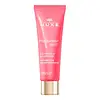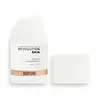What's inside
What's inside
 Key Ingredients
Key Ingredients

 Benefits
Benefits

 Concerns
Concerns

 Ingredients Side-by-side
Ingredients Side-by-side

Water
Skin ConditioningAlcohol Denat.
AntimicrobialGlycerin
HumectantPhenyl Trimethicone
Skin ConditioningHydroxyethyl Acrylate/Sodium Acryloyldimethyl Taurate Copolymer
Emulsion StabilisingPropylheptyl Caprylate
EmollientSilica
AbrasiveParfum
MaskingPhenoxyethanol
PreservativeEthylhexylglycerin
Skin ConditioningAcrylates/C10-30 Alkyl Acrylate Crosspolymer
Emulsion StabilisingRibose
HumectantSodium Gluconate
Skin ConditioningXanthan Gum
EmulsifyingButylene Glycol
HumectantSodium Hyaluronate
HumectantPolysorbate 60
EmulsifyingSorbitan Isostearate
EmulsifyingPentylene Glycol
Skin ConditioningJasminum Officinale Flower Extract
MaskingSodium Hydroxide
BufferingFaex Extract
Skin ConditioningMica
Cosmetic ColorantCI 77491
Cosmetic ColorantCalendula Officinalis Flower Extract
MaskingTocopherol
AntioxidantBenzyl Salicylate
PerfumingLinalool
PerfumingCitronellol
PerfumingAlpha-Isomethyl Ionone
PerfumingGeraniol
PerfumingWater, Alcohol Denat., Glycerin, Phenyl Trimethicone, Hydroxyethyl Acrylate/Sodium Acryloyldimethyl Taurate Copolymer, Propylheptyl Caprylate, Silica, Parfum, Phenoxyethanol, Ethylhexylglycerin, Acrylates/C10-30 Alkyl Acrylate Crosspolymer, Ribose, Sodium Gluconate, Xanthan Gum, Butylene Glycol, Sodium Hyaluronate, Polysorbate 60, Sorbitan Isostearate, Pentylene Glycol, Jasminum Officinale Flower Extract, Sodium Hydroxide, Faex Extract, Mica, CI 77491, Calendula Officinalis Flower Extract, Tocopherol, Benzyl Salicylate, Linalool, Citronellol, Alpha-Isomethyl Ionone, Geraniol
Water
Skin ConditioningGlycerin
HumectantButyrospermum Parkii Butter
Skin ConditioningGlyceryl Stearate
EmollientAvena Sativa Kernel Flour
AbrasiveTheobroma Cacao Seed Butter
EmollientSqualane
EmollientPhenoxyethanol
PreservativeCetearyl Alcohol
EmollientAmmonium Acryloyldimethyltaurate/Vp Copolymer
Sodium Acrylate/Sodium Acryloyldimethyl Taurate Copolymer
Emulsion StabilisingC15-19 Alkane
SolventCetearyl Glucoside
EmulsifyingPentylene Glycol
Skin ConditioningDisodium EDTA
Ethylhexylglycerin
Skin ConditioningPolyglyceryl-6 Laurate
EmulsifyingFructose
HumectantUrea
BufferingCitric Acid
BufferingSodium Hydroxide
BufferingPolyglycerin-6
HumectantMaltose
MaskingSodium PCA
HumectantSodium Chloride
MaskingSodium Lactate
BufferingTrehalose
HumectantAllantoin
Skin ConditioningCeramide NP
Skin ConditioningGlucose
Humectant2,3-Butanediol
HumectantHydrogenated Lecithin
EmulsifyingSodium Hyaluronate
HumectantPalmitoyl Tripeptide-5
Skin ConditioningPalmitoyl Dipeptide-5 Diaminobutyroyl Hydroxythreonine
Skin ConditioningMagnesium Chloride
Tetradecyl Aminobutyroylvalylaminobutyric Urea Trifluoroacetate
Skin ConditioningCholesterol
EmollientCeramide AP
Skin ConditioningCeramide As
Skin ConditioningCeramide Ns
Skin ConditioningCeramide EOP
Skin ConditioningWater, Glycerin, Butyrospermum Parkii Butter, Glyceryl Stearate, Avena Sativa Kernel Flour, Theobroma Cacao Seed Butter, Squalane, Phenoxyethanol, Cetearyl Alcohol, Ammonium Acryloyldimethyltaurate/Vp Copolymer, Sodium Acrylate/Sodium Acryloyldimethyl Taurate Copolymer, C15-19 Alkane, Cetearyl Glucoside, Pentylene Glycol, Disodium EDTA, Ethylhexylglycerin, Polyglyceryl-6 Laurate, Fructose, Urea, Citric Acid, Sodium Hydroxide, Polyglycerin-6, Maltose, Sodium PCA, Sodium Chloride, Sodium Lactate, Trehalose, Allantoin, Ceramide NP, Glucose, 2,3-Butanediol, Hydrogenated Lecithin, Sodium Hyaluronate, Palmitoyl Tripeptide-5, Palmitoyl Dipeptide-5 Diaminobutyroyl Hydroxythreonine, Magnesium Chloride, Tetradecyl Aminobutyroylvalylaminobutyric Urea Trifluoroacetate, Cholesterol, Ceramide AP, Ceramide As, Ceramide Ns, Ceramide EOP
Ingredients Explained
These ingredients are found in both products.
Ingredients higher up in an ingredient list are typically present in a larger amount.
Ethylhexylglycerin (we can't pronounce this either) is commonly used as a preservative and skin softener. It is derived from glyceryl.
You might see Ethylhexylglycerin often paired with other preservatives such as phenoxyethanol. Ethylhexylglycerin has been found to increase the effectiveness of these other preservatives.
Glycerin is already naturally found in your skin. It helps moisturize and protect your skin.
A study from 2016 found glycerin to be more effective as a humectant than AHAs and hyaluronic acid.
As a humectant, it helps the skin stay hydrated by pulling moisture to your skin. The low molecular weight of glycerin allows it to pull moisture into the deeper layers of your skin.
Hydrated skin improves your skin barrier; Your skin barrier helps protect against irritants and bacteria.
Glycerin has also been found to have antimicrobial and antiviral properties. Due to these properties, glycerin is often used in wound and burn treatments.
In cosmetics, glycerin is usually derived from plants such as soybean or palm. However, it can also be sourced from animals, such as tallow or animal fat.
This ingredient is organic, colorless, odorless, and non-toxic.
Glycerin is the name for this ingredient in American English. British English uses Glycerol/Glycerine.
Learn more about GlycerinPentylene glycol is typically used within a product to thicken it. It also adds a smooth, soft, and moisturizing feel to the product. It is naturally found in plants such as sugar beets.
The hydrophilic trait of Pentylene Glycol makes it a humectant. As a humectant, Pentylene Glycol helps draw moisture from the air to your skin. This can help keep your skin hydrated.
This property also makes Pentylene Glycol a great texture enhancer. It can also help thicken or stabilize a product.
Pentylene Glycol also acts as a mild preservative and helps to keep a product microbe-free.
Some people may experience mild eye and skin irritation from Pentylene Glycol. We always recommend speaking with a professional about using this ingredient in your routine.
Pentylene Glycol has a low molecular weight and is part of the 1,2-glycol family.
Learn more about Pentylene GlycolPhenoxyethanol is a preservative that has germicide, antimicrobial, and aromatic properties. Studies show that phenoxyethanol can prevent microbial growth. By itself, it has a scent that is similar to that of a rose.
It's often used in formulations along with Caprylyl Glycol to preserve the shelf life of products.
Sodium Hyaluronate is hyaluronic acid's salt form. It is commonly derived from the sodium salt of hyaluronic acid.
Like hyaluronic acid, it is great at holding water and acts as a humectant. This makes it a great skin hydrating ingredient.
Sodium Hyaluronate is naturally occurring in our bodies and is mostly found in eye fluid and joints.
These are some other common types of Hyaluronic Acid:
Learn more about Sodium HyaluronateSodium Hydroxide is also known as lye or caustic soda. It is used to adjust the pH of products; many ingredients require a specific pH to be effective.
In small amounts, sodium hydroxide is considered safe to use. However, large amounts may cause chemical burns due to its high alkaline.
Your skin has a natural pH and acid mantle. This acid mantle helps prevent harmful bacteria from breaking through. The acid mantle also helps keep your skin hydrated.
"Alkaline" refers to a high pH level. A low pH level would be considered acidic.
Learn more about Sodium HydroxideWater. It's the most common cosmetic ingredient of all. You'll usually see it at the top of ingredient lists, meaning that it makes up the largest part of the product.
So why is it so popular? Water most often acts as a solvent - this means that it helps dissolve other ingredients into the formulation.
You'll also recognize water as that liquid we all need to stay alive. If you see this, drink a glass of water. Stay hydrated!
Learn more about Water